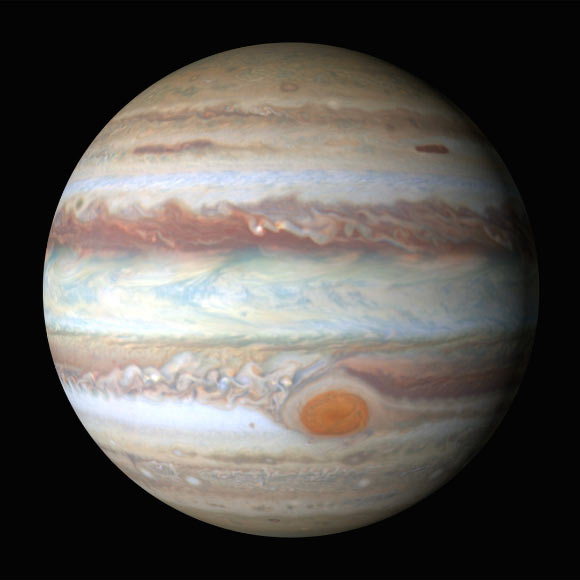As NASA’s Juno probe makes its closest flyby of the gas giant, new research from France’s space agency could help make more sense of the data it sends back. Their paper is the latest in a global effort to refine our planetary models to ensure Juno’s measurements of the planet’s gravitational field can answer questions like ‘Did Jupiter form closer to the Sun and then move out?’ and ‘Is helium rain continuously falling on a supersized Jovian core of metallic hydrogen?’
The composition of Jupiter’s interior, in particular the presence of ‘heavy elements’ (those heavier than hydrogen and helium that make up the bulk of the planet), is key to understanding its origin and that of our Solar System as a whole.
“Jupiter was one of the first planets to form in our planetary system from the primitive nebula,” says Yamilla Miguel, from the French space agency CNES. “The gas and solids in its interior preserve valuable information on the physics and chemistry of this nebula.”
Hidden 1,000s of kilometers below its opaque cloud tops, researchers have had to develop theoretical models, using measurements of Jupiter’s gravitational field taken by Pioneer and Voyager, to estimate the amount and distribution of heavy elements down below. These measurements are being refined by the Juno probe during its closest flybys.
However, even with these more precise data, a detailed picture may remain out of reach without one final component.
“The behavior of the planet’s hydrogen and helium under the extreme conditions found deep in the interior is crucial,” says Professor Ronald Redmer, a planetary physicist at the University of Rostock. “However these pressures and temperatures are exceptionally hard to achieve in the lab.”
As a result scientists have had to settle for predictions of behavior which have been used to put forward various different interior structures — from a small but heavy-element rich Jovian core, around 8 times the size of Earth, to a supersized but heavy element depleted core, up to 18 times the mass of our home planet — in order to fit with observations of the planet’s gravitational field.
“Those producing these various equations of state have used different models to make the resulting implications on the interior structure of the planet match observed gravitational measurements. It wasn’t a fair comparison,” says Miguel.
So in their new paper, published in the journal Astronomy & Astrophysics, Miguel and colleagues took the latest selection of equations of state values, and applied them to just one, popular model.
The aim was to provide a comparison of current work using a model the team hope Juno will be able to challenge or validate with the data it sends back.
By feeding new data into their equations, Miguel believes, we should be able to narrow down on the planet’s true internal structure and composition.
“This new paper is a really interesting contribution to the field,” agrees Redmer. However, he expresses concern around Miguel’s consideration of one of strangest phenomenon thought to be found deep within Jupiter’s interior.
Helium rain was first inferred from the Galileo probe, which revealed surprisingly low quantities of helium in Jupiter’s upper atmosphere.
This measurement has been attributed to helium being rained out and concentrated in the interior, and Miguel’s models include the process and its effect on the abundance of the gas in both the outer and deeper layer. It’s here Redmer raises a note of caution.
“When these droplets fall they release an additional energy source that should slow down the gradual cooling of the planet. On Saturn we have evidence for this effect. However, it is not clear it’s happening on Jupiter.”
What is more certain is a better understanding of Jupiter’s interior will help reveal more about the formation of the Solar System.
For example, the amount of water could answer questions over whether Jupiter formed much closer to the Sun before eventually moving out to the position we observe it in today. Such a historic journey should have left a tale signature, such as a lower than expected proportion of water in the planet’s center.
“This migration would also have affected all the other bodies in the Solar System,” says Miguel, “including the seed of our own planet.”
_____
Y. Miguel et al. 2016. Jupiter internal structure: the effect of different equations of state. A&A 596, A114; doi: 10.1051/0004-6361/201629732








